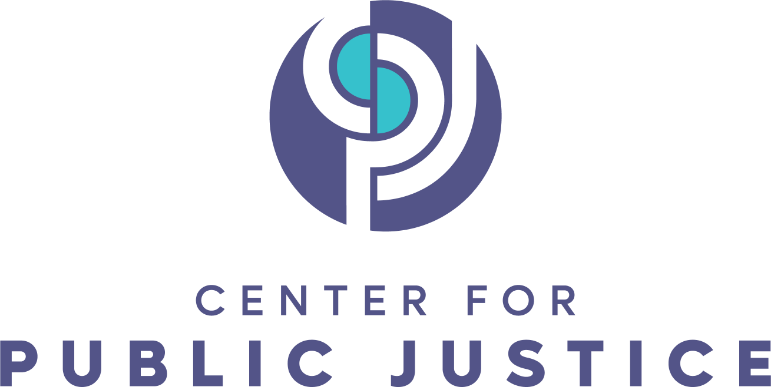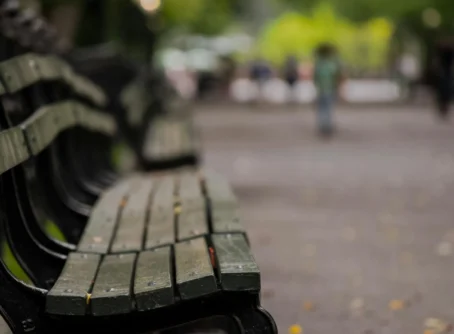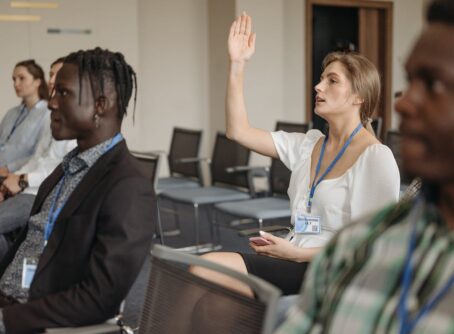
Anna Cole was a 2020 recipient of the Center for Public Justice’s Hatfield Prize. Cole (Wheaton College ‘21) and faculty advisor Timothy W. Taylor, Ph.D., researched the impact of predatory lending on under-resourced communities and identified promising models for responsible credit options in DuPage County, Illinois.
DISCOVER
It all started with a flyer advertising “Cash Today!”. Dave, a young, divorced father of two, just needed $200 to get extra groceries because it was his weekend with the children. He was working full-time as a sales representative, but an unexpected car repair had recently drained his savings account. His bank didn’t offer loans below a $1,000 minimum and the application process would take several weeks – time he didn’t have. He worried that his poor credit score might disqualify him anyways. Dave noted the address listed on the flyer and walked into a payday loan storefront a few hours later. He was greeted warmly and approved for a loan within 30 minutes of entering the store. All he had to do was provide proof of employment.
Two weeks later, the full $200 plus $30 in interest and fees were due, and Dave simply didn’t have the money. The lender encouraged Dave to just pay the fees and interest and “roll over” the loan for another two weeks. This happened 11 more times before Dave was able to pay off the original loan. In the end, he paid $530 for those $200 groceries, which amounted to a 165 percent interest rate. During this time, Dave fell behind on his rent payments, creating an additional source of financial stress and leading him to take out another short-term loan.
Though Dave’s story is a fictional one, it represents the experience of millions of families across the United States. Over 12 million Americans take out a payday loan each year. Payday loans are small dollar (typically $500 or less), short-term, high-interest loans, with an average annual percentage rate (APR) of 400 percent. The loans, including interest and fees, are typically expected to be repaid in two weeks – at the borrower’s next payday – and all that is required to obtain a loan is a pay stub. The borrower’s ability to repay the loan is rarely assessed, and lenders are granted direct access to a borrower’s bank account through a post-dated check or an electronic ACH authorization.
However, payday lenders are only profitable when borrowers are unable to repay the original cost of the loan plus interest and fees – in other words, when borrowers fail. When borrowers are unable to repay the loan in the original two-week window, they are often encouraged by lenders to “roll over” or “flip” the loan, meaning that they either pay a fee to extend the loan window another two weeks, or they take out a new loan to cover the cost of the first. One in four loans are rolled over nine times or more. While borrowers continue to pay interest and fees, their principal remains the same. On average, borrowers will pay $520 in fees for what originated as a $375 loan. As borrowers take out multiple loans to repay the original cost of the loan, plus continue to incur all other regular expenses, they become stuck in what’s known as a debt trap.
“Payday lenders are only profitable when borrowers are unable to repay the original cost of the loan plus interest and fees – in other words, when borrowers fail.
In 2017, there were roughly 14,350 payday loan storefronts in the United States. By comparison, McDonald’s has roughly 14,000 locations nationwide. While marketed as a stop-gap between an immediate need and a coming paycheck, payday loans are often utilized to cover basic, recurring expenses rather than meeting a one-time need, indicating that most borrowers are already financially vulnerable. Five groups are significantly overrepresented among payday loan borrowers: home renters; African Americans; borrowers with an annual income below $40,000; borrowers without a four-year college degree; and single parents, either separated or divorced. Payday lenders are disproportionately concentrated in low- and moderate-income communities of color, which contributes to the overrepresentation of these groups.
Prior to the 1980s, states had usury laws that capped interest on small dollar loans at 36 percent. However, in the 1980s and 1990s, state legislatures began to amend and loosen these laws. This allowed for the payday loan industry to emerge and begin exploiting borrowers through predatory practices like deceptive marketing, failure to assess a borrower’s ability to repay, repeated flipping of loans, and strategic concentration in communities where families experience significant financial hardship.
Short-Term Cash, Long-Term Consequences
There is a significant body of literature detailing the detrimental short-term and long-term impacts of payday loan usage. Payday loans negatively impact long-term financial health, as borrowers often end up diverting a significant amount of household income to paying back the loan. On average, payday loan borrowers are in debt for 212 days out of the year. The average borrower earns $31,000 in annual household income, so this burden places additional strain on households that are often already financially stretched thin. The long-term effects are clear: payday loan usage is correlated with nearly doubled bankruptcy rates. The stress created by payday loans can lead to absenteeism at work, further exacerbating economic hardship on stretched households.
The impact of payday loans on borrowers is not limited to financial hardship: physical health also suffers when families are trapped in a cycle of debt. A recent research study from the University of Washington found that the use of short-term, high cost products like payday loans is linked to a 38 percent higher prevalence of poor or fair health, as self-rated by borrowers in the nationally representative Current Population Survey. Borrowers are more likely to delay receiving medical and dental care, as well as prescription drugs, due to the financial burden of debt servicing. These consequences are not unique to payday loan debt, as unsecured personal and household debt is also strongly correlated with increased rates of stress, depression, high blood pressure, and worse self-reported general health.
“As families begin to build credit and enter the financial mainstream, whole communities will benefit from their increased well-being and financial security.
The psychological stress and shame generated by the payday loan debt trap can lead to strained marriages and relationships. Debt is directly linked to increased marital conflict, which can lead to divorce. Households that use payday loans are 10 percent less likely to make child support payments, as debt servicing diverts normal cash flow. Additionally, the debt trap created by payday loans poses a particular threat to domestic violence survivors, 99 percent of whom have also experienced financial abuse like blocked access to personal bank accounts or the intentional destruction of a victim’s credit. As a result, survivors often lack access to mainstream credit. Falling into the debt spiral of payday loans leaves victims of domestic abuse vulnerable to further physical violence as the borrower can lose economic independence.
The debt incurred as a result of payday loans not only affects individual borrowers, it also impacts entire communities. Geographic analysis demonstrates that payday lenders concentrate in under-resourced communities of color. Payday lenders both perpetuate and exacerbate existing housing and economic inequality by draining vital capital from neighborhoods through exorbitant fees and loan rollovers.
The Legislative and Regulatory Landscape
The detrimental effects of payday loans on the financial, social, emotional, and physical health of individuals are well documented, and yet predatory lenders continue to operate in many communities across the United States. In recent years, though, government has taken some steps to curtail lenders’ abilities to extend these loans.
At a federal level, only Congress has the ability to enact a rate cap that would limit the interest rate payday lenders are able to charge. In 2006, Congress enacted the Military Lending Act, which caps interest rates at 36 percent for payday loans made to active duty military service members. In November 2019, the bipartisan Veterans and Consumers Fair Credit Act was introduced in Congress by Representatives Jesús “Chuy” García (D-IL) and Glenn Grothman (R-WI). The legislation would extend the 36 percent interest rate cap to all consumers, not only military service members. The bill remains in the House Committee on Financial Services and has yet to be passed out of the committee.
The Consumer Financial Protection Bureau (CFPB), the federal agency responsible for consumer protection, also has the ability to curtail some of the practices of payday lenders described earlier. While it is not authorized to enact a federal rate cap, the CFPB has rulemaking authority, meaning it can issue legal directives on how federal laws should be interpreted and implemented. In 2017 the CFPB finalized its “Payday, Vehicle Title, and Certain High-Cost Installment Loans” rule. The rule, among other things, includes an ability-to-repay provision, which requires lenders to assess a borrower’s ability to repay the loan by verifying the borrower’s net income, living expenses, and financial obligations before extending the loan. However, before it could go into effect, the CFPB, under new leadership, announced in January 2019 its plans to rescind the ability-to-repay requirement and also released a final, weakened rule in July 2020.
Despite this, in response to what is recognized as a growing debt crisis, some states have passed legislation to limit the predatory practices of payday lenders under their jurisdiction. As of 2019, 17 states and the District of Columbia effectively banned payday loans by passing legislation that limits annual interest rates to 36 percent or below. The payday loan business model relies on short-term loan structures, rollover fees, and exorbitant interest rates to cover operating costs. A 36 percent annual interest rate cap – based on a 100-year historical precedent as well as widespread acceptance at the state and federal level prior to the 1980s – essentially prohibits payday loans by making the business model inoperable because lenders can’t make a profit. Much of this change has come through ballot initiatives: citizens recognizing the negative repercussions of payday loans and voting to make a difference. In South Dakota, for example, a 2016 rate cap initiative overwhelmingly passed with 76 percent of the vote. Two years later, South Dakotans still showed strong, continued support for the 36 percent rate cap.
Addressing the Root Issues
While legislation and regulation of predatory practices is necessary, it’s important to also consider underlying conditions – such as chronic financial instability and a lack of access to traditional credit – that lead borrowers to turn to payday loans in the first place.
According to a 2019 report from the Federal Reserve, roughly 40 percent of Americans would be unable to cover a $400 emergency expense using cash, savings, or a credit card paid off at the next statement. This chronic financial instability, coupled with inaccessible traditional forms of credit, puts families in a precarious position. Indeed, 33 percent of Americans are either unable to pay their bills at the end of the month or would be unable to if an unexpected expense arose. The issues contributing to financial instability, such as the lack of a stable income or living wage, a lack of savings, and poor financial literacy, must be recognized and addressed in tandem with the development of accessible, low-to-moderate interest credit and government regulation of predatory lending.
“Addressing the root causes and harms of predatory lending requires a healthy ecosystem of responsible financial practices that empower rather than entrap.
Access to credit is essential in the modern economy. Yet 8.4 million Americans are unbanked, meaning that they do not have access to a checking or savings account. An additional 24.2 million are underbanked, reliant on alternative financial services such as non-bank check-cashing services and pawn shops, despite having access to a checking or savings account. Low cash reserves contribute to this issue: according to the 2017 Federal Deposit Insurance Corporation (FDIC) National Survey of Unbanked and Underbanked Households, 52 percent of unbanked households reported that they “do not have enough money to keep in an account” as a reason for not opening a bank account. The unbanked and underbanked are often unable to build their credit rating, making mainstream personal credit products like credit cards and bank loans virtually inaccessible. Locked out of the mainstream credit market, borrowers often turn to payday loans in times of financial need.
However, rather than pulling borrowers out of a temporary financial crisis as promised, one payday loan often leads to another, due to the short-term loan structure combined with high interest rates that make it difficult to pay off on time. Simultaneously, payday loans fail to contribute to borrowers’ credit records, regardless of whether or not they are paid off on time. Since payday loans don’t build credit, borrowers are further shut out from the financial mainstream. Payday lenders typically require no demonstration of ability to repay the loan, only proof of employment. Lenders claim to stand in the existing credit gap, but end up trapping consumers in vicious debt cycles.
A Healthy Ecosystem for Responsible Lending
Addressing the root causes and harms of predatory lending requires a healthy ecosystem of responsible financial practices that empower rather than entrap. This ecosystem is comprised of a network of institutions that includes government, lenders committed to offering responsible credit, and secular and faith-based nonprofits, including houses of worship, that assist borrowers in escaping the debt trap and equip them to establish and build credit for long-term financial stability. Each of these institutions has a unique role and responsibility to address predatory lending in communities, the details of which will be explored in the following section. As families begin to build credit and enter the financial mainstream, whole communities will benefit from their increased well-being and financial security.
Read the rest of “Predatory Lending and the Need for a Healthy Financial Ecosystem,” which includes the research team’s recommendations for addressing predatory lending through public policy and civil society, and a case study of DuPage County, Illinois.
Anna Cole is a senior at Wheaton College in Illinois, where she is pursuing a double major in international relations and music. She completed her research for The Hatfield Prize during her junior year. Cole is the student chair and co-founder of Voices in the Near East (VINE), a student organization committed to furthering interfaith relationships and reframing campus conversation surrounding the Near East. She was a fellow with Neighborly Faith and presented on VINE at the Neighborly Faith Conference in 2019. Her research and undergraduate experiences have focused on the intersection of music and migration – she interned at a refugee resettlement agency in her hometown, Colorado Springs, taught music workshops and violin lessons to refugee students in Germany and Turkey, and received competitive grant funding to conduct independent research on Syrian musicians in Istanbul over the summer of 2019. She has also worked as a research assistant in Wheaton’s International Relations and Anthropology departments.
Timothy W. Taylor, Ph.D., is a professor of politics and international relations at Wheaton College, where he enjoys teaching classes ranging from International Political Economy to East Asian Politics. His research, which includes the effects of foreign trade agreements upon national elections, has been published in both academic journals, as well as outlets such as Christianity Today and the Huffington Post. Taylor was awarded the Rothchild Memorial Research Award, and in 2015, was appointed as a fellow at Ateneo de Manila University’s Center for Asian Studies. He earned his MA and PhD from the University of California, Davis, where he was a Bilinski Fellow from 2015-2016. After living and traveling abroad, Taylor and his wife now reside in Wheaton, IL with their four children.





